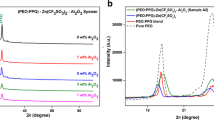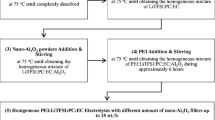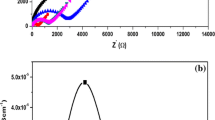Abstract
The ZrO2-filled PVA/NaClO4 polymer nanocomposite is a freestanding electrolyte film and is prepared using the solution casting method in an aqueous medium. These prepared samples were characterized for structural, morphological, optical, thermal, and electrical properties. FT Raman studies confirmed the interaction between PVA and NaClO4, and dispersion of ZrO2 fillers in the PVA/NaClO4 polymer electrolyte. The surface roughness was observed from AFM images. Fitting the values of UV absorption to Tauc’s equation, the optical energy band gaps have been evaluated and correlated to the electrical conductivity. The maximum electrical conductivity of 4.3 × 10−3 (± 0.0002) S/cm was obtained for 3 wt% ZrO2-filled PVA/NaClO4 polymer nanocomposite. The thermal degradation kinetic parameter was calculated by fitting thermo gravimetric analysis values in Broid’s model.

Possible interaction of ZrO2 filled PVA/NaClO4 reflected in Raman peaks in FT-Raman spectra













Similar content being viewed by others
References
Jancar J, Douglas JF, Starr FW, Kumar SK, Cassagnau P, Lesser AJ, Sternstein SS, Buehler MJ (2010) Current issues in research on structure property relationships in polymer nanocomposites. Polymer 51:3321–3343
Yang R, Ogitani S, Paul K, Wong CP (2002) Novel polymer–ceramic nanocomposite based on high dielectric constant epoxy formula for embedded capacitor application. J Appl Polym Sci 83:1084–1090
Huanan W, Yubao L, Zuo Y, Jihua L, Sansi M, Cheng L (2007) Biocompatibility and osteogenesis of biomimetic nano-hydroxyapatite/polyamide composite scaffolds for bone tissue engineering. Biomaterials 28:3338–3348
Vallerie HD, Thanh DN, Mangesh N, Nandika AD, Teresa DG (2012) Polymer nanocomposites for improved drug delivery efficiency. Mater Chem Phys 132:409–415
Sheng-Wen Z, Shu-Xue Z, Yu-Ming W, Li-Min W (2005) Synthesis of SiO2/polystyrene nanocomposite particles via miniemulsion polymerization. Langmuir 21:2124–2128
Steven H (2014) Fuel cell catalyst layers: a polymer science perspective. Chem Mater 26:381–393
Jinyao C, Cindy XZ, Matthew MZ, Wang K, Deng L, Xu G (2012) Alkaline direct oxidation glucose fuel cell system using silver/nickel foams as electrodes. Electrochim Acta 66:133–138
Adam JG, Rona C, Andrew JC, Colleen L, Coline J, Arbel AS, Daniel A, Irene Y, Molly MS (2015) Layer-by-layer self-assembly of polymer films and capsules through coiled-coil peptides. Chem Mater 27:5820−5824
Zheng-Ming H, Zhang YZ, Kotaki M, Ramakrishna S (2003) A review on polymer nano-fibers by electro-spinning and their applications in nano-composites. Compos Sci Technol 63:2223–2253
Feng H, Yugang S, Anshu G, Matthew AM, Lise B, Lolita R, Jingfeng W, Phil G, Moonsub S, John AR (2004) Polymer imprint lithography with molecular-scale resolution. Nano Lett 4(12)
Long Y, Katherine D, Lin L (2006) Polymer blends and composites from renewable resources. Prog Polym Sci 31:576–602
Lucy LD, Cindy XZ, Yiqun M, Sean SC, Xu G (2013) Low cost acetone sensors with selectivity over water vapor based on screen printed TiO2 nanoparticles. Anal Methods 5:3709
Kevin KW, Han Y, Cindy XZ, Xu G, Yu Q, Wu Y, Hu N-X (2010) Direct method of tracing the wetting states on nanocomposite surfaces. Langmuir 26(11):7686–7689
Cindy XZ, Steven X, Gu X (2015) Density of organic thin films in organic photovoltaics. J Appl Phys 118:044510
Paul DR, Robeson LM (2008) Polymer nanotechnology: nanocomposites. Polymer 49:3187–3204
Wang H, Xu P, Zhong W, Liang S, Qiangguo D (2005) Transparent poly(methyl methacrylate)/silica/zirconia nanocomposites with excellent thermal stabilities. Polym Degrad Stab 87:319–327
Young MK, Chang JB, Su-Hee L, Hae-W K, Hyoun EK (2005) Improvement in biocompatibility of ZrO2–Al2O3 nanocomposite by addition of HA. Biomaterials 26:509–517
Xue B, Andrea P, Vania TF, Rute ASF, Nicola P (2012) One-step synthesis and optical properties of benzoate- and biphenolate-capped ZrO2 nanoparticles. Adv Funct Mater 22:4275–4283
Cao HQ, Qiu XQ, Luo B, Liang Y, Zhang YH, Tan RQ, Zhao MJ, Zhu QM (2004) Synthesis and room-temperature ultraviolet photoluminescence properties of zirconia nanowires. Adv Funct Mater 3:243–246
Junkai Z, Shengsong G, Lirong L, Qian S, Xianmin M, Cindy XZ, Luhan H, Tingting W, Zepei Y, Zhanhu G (2018) Microwave solvothermal fabrication of zirconia hollow microspheres with different morphologies using pollen templates and their dye adsorption removal. Ind Eng Chem Res 57(1):231–241
Jose FB, Anton S, Heinz-D K, Janet G, Frank AM (2016) New ZrO2/Al2O3 nanocomposite fabricated from hybrid nanoparticles prepared by CO2 laser Co-vaporization. Sci Rep 6:20589
Sangkyu L, Hyeon-Jin S, Seon-Mi Y, Dong Kee Y, Jae-Young C, Ungyu P (2008) Refractive index engineering of transparent ZrO2–poly dimethyl siloxane nanocomposites. J Mater Chem 18:1751–1755
Nikhil HJ, Katherine D, Ravindra D (2005) Synthesis and characterization of Nafion® - MO2 (M = Zr, Si, Ti) nanocomposite membranes for higher temperature PEM fuel cells. Electrochim Acta 51:553–560
Basudam A, Sarmishtha M (2004) Polymers in sensor applications. Prog Polym Sci 29:699–766
Martin Z, Anja H, Alex F, Helmut S, Christian S, Georg J, Gunther L, Barbara S, Ingrid G, Norbert G, Reinhard S, Simona BG, Siegfried B (2007) Low-voltage organic thin-film transistors with high-k nanocomposite gate dielectrics for flexible electronics and optothermal sensors. Adv Mater 19:2241–2245
Shadpour M, Ahmadreza NE (2015) A simple and environmentally friendly method for surface modification of ZrO2 nanoparticles by biosafe citric acid as well as ascorbic acid (vitamin C) and its application for the preparation of poly(vinyl chloride) nanocomposite films. Polym Compos. https://doi.org/10.1002/pc.23746
Xiaodong W, Xianhu L, Hongyue Y, Hu L, Chuntai L, Tingxi L, Chao Y, Xingru Y, Changyu S, Zhanhu G (2018) Non-covalently functionalized graphene strengthened poly(vinyl alcohol). Mater Des 139:372–379
Saligheh O, Khajavi R, Yazdanshenas ME, Rashidi A (2015) Fabrication and optimization of poly(vinyl alcohol)/zirconium acetate electrospun nanofibers using Taguchi experimental design. J Macromol Sci Phys 54:1391–1403
Jagadish N, Bhajantri RF (2018) Physical and electrochemical studies on ceria filled PVA proton conducting polymer electrolyte for energy storage applications. J Inorg Organomet Polym Mater. https://doi.org/10.1007/s10904-018-0801-3.
Wei D, Suying W, Jiahua Z, Xuelong C, Dan R, Zhanhu G (2010) Manipulated electrospun PVA nanofibers with inexpensive salts. Macromol Mater Eng 295:958–965
Arumugam M, Xingwen Y, Shaofei W (2017) Lithium battery chemistries enabled by solid-state electrolytes. Nat Rev Mater 2(16103):1–16
Clement B, Xiulei J (2018) Electrolytes, SEI formation, and binders: a review of nonelectrode factors for sodium ion battery anode. Small 1703576:1–20
Mohammed IJ, Prakash AS (2018) Advancement of technology towards developing Na-ion batteries. J Power Sources 378:268–300
Premkumar S, Gwenaelle R, Vincent S, Tarascon JM, Palacin MR (2011) Na2Ti3O7: lowest voltage ever reported oxide insertion electrode for sodium ion batteries. Chem Mater 23:4109–4111
Bhargav PB, Mohan VM, Sharma AK, Rao VVRN (2007) Structural, electrical and optical characterization of pure and doped poly (vinyl alcohol) (PVA) polymer electrolyte films. Int J Polym Mater 56:579–591
Alexandre P, Elena M, Matthieu C, Jean MT, Palacin MR (2012) In search of an optimized electrolyte for Na-ion batteries. Energy Environ Sci 5:8572
Ponrouch A, Monti D, Boschin A, Steen B, Johansson P, Palacin MR (2015) Non-aqueous electrolytes for sodium-ion batteries. J Mater Chem A 3:22–42
Amrtha B, Jonas H, Anna KD, Jurgen J, Philipp A (2014) Electrochemical stability of non-aqueous electrolytes for sodium-ion batteries and their compatibility with Na0.7 CoO2. Phys Chem Chem Phys 16:1987
Hebbar V, Bhajantri RF, Naik J (2017) Physico-chemical properties of bismuth nitrate filled PVA-LiClO4 composites for energy storage applications. J Mater Sci Mater Electron 28:5827–5839
Naik J, Bhajantri RF, Sheela T, Rathod SG (2016) Role of ZrO2 on physico-chemical properties of PVA/NaClO4 composites for energy storage applications. Polym Compos. https://doi.org/10.1002/pc.24063
Moses E, Andre W, Ellen IT (2013) A novel method for measuring the effective conductivity and the contact resistance of porous electrodes for lithium-ion batteries. Electrochem Commun 34:130–133
Schantz S (1991) On the ion association at low salt concentrations in polymer electrolytes; a Raman study of NaCF3SO3 and LiClO4 dissolved in poly (propylene oxide). J Chem Phys 94:6296
Pitchai JV, Bijan D, Dilip KH (2001) A study on the solvation phenomena of some sodium salts in 1,2-dimethoxyethane from conductance, viscosity, ultrasonic velocity, and FT-Raman spectral measurements. J Phys Chem A 105(24):5960–5964
Jayakumar S, Ananthapadmanabhan PV, Perumal K, Thiyagarajan TK, Mishra SC, Su LT, Tok AIY, Guo J (2011) Characterization of nano-crystalline ZrO2 synthesized via reactive plasma processing. Mater Sci Eng B 176:894–899
Gunasekaran S, Sailatha E, Seshadri S, Kumaresan S (2009) FTIR, FT Raman spectra and molecular structural confirmation of ionized. Indian J Pure Appl Phys 47:12–18
Sareen S, Nagaraja GK, Jagadish N, Bhajanthri RF (2017) Development and characterization study of silk fibre reinforced poly(vinyl alcohol) composites. Int J Plast Technol 21(1):108–122
Shadpour M, Leila M (2014) Improvement of the interactions between modified ZrO2 and poly(amide-imide) matrix by using unique biosafe diacid as a monomer and coupling agent. Polym-Plast Technol Eng 53:1574–1582
Xi Z, Xingru Y, Qingliang H, Huige W, Jun L, Jiang G, Hongbo G, Jingfang Y, Jingjing L, Daowei D, Luyi S, Suying W, Zhanhu G (2015) Electrically conductive polypropylene nanocomposites with negative permittivity at low carbon nanotube loading levels. ACS Appl Mater Interfaces 7:6125–6138
Vidyashree H, Bhajantri RF, Jagadish N, Sunil GR (2016) Thiazole yellow G dyed PVA films for optoelectronics: microstructrural, thermal and photophysical studies. Mater Res Express 3:075301
Liew CW, Ramesh S, Arof AK (2015) Characterization of ionic liquid added poly(vinyl alcohol)-based proton conducting polymer electrolytes and electrochemical studies on the super capacitors. Int J Hydrogen Energy 40:852–862
Bo J, Juan S, Rufang P, Yuanjie S, Bisheng T, Shijin C, Haishan D (2012) Synthesis, characterization, thermal stability and sensitivity properties of the new energetic polymer through the azidoacetylation of poly(vinyl alcohol). Polym Degrad Stab 97:473–480
Haigang Y, Shoubin X, Yuanqing S, Jianling Z, Long J, Yi D (2014) Study of the thermal decomposition behavior of poly(vinyl alcohol) with NaHSO4. J Macromol Sci B 53:1059–1073
Broido A (1969) A simple, sensitive graphical method of treating thermo-gravimetric analysis data. J Polym Sci A-2 7:1761–1773
Karthika JS, Vishalakshi B, Naik J (2016) Gellan gum graft polyaniline, an electrical conducting biopolymer. Int J Biol Macromol 82:61–67
Rajendran S, Uma T (2000) Effect of ceramic oxide on PVC-PMMA hybrid polymer electrolytes. Ionics 6:288–293
Gustav EK, Daniel B (2017) Li-ion batteries using electrolyte based on mixtures of poly(vinyl alcohol) and lithium bis(trifluoro methane) sulfonamide salt. Electrochemica acta 246:208–212
Genova FKM, Selvasekarpandian S, Vijaya N, Sivadevi S, Premalatha M, Karthikeyan S (2017) Lithium ion conducting polymer electrolyte based on PVA-PAN doped with lithium triflate. Ionics 23(10):2727–2734
Haung YF, Zhang MQ, Rong MZ, Ruan WH (2017) To immobilize poly ethylene glycol-borate/lithium fluoride in graphene oxide/polyvinyl alcohol for synthesizing new polymer electrolyte membrane of lithium ion batteries. Express Polym Lett 11(1):35–46
Acknowledgements
The authors are thankful to USIC, Karnatak University, Dharwad, for FT Raman, TGA, and AFM facilities.
Funding
One of the authors, Vidyashree Hebbar, received UGC-UPE Research fellowship (KU/Sch/UGC-UPE/2014-15/890) from Karnatak University, Dharwad. This study received financial support from the Science and Engineering Research Board (SERB), Department of Science and Technology (DST), Government of India, research projects SR/FTP/PS-011/2010 and SB/EMEQ-089/2013, and UGC, New Delhi, SAP-CAS Phase-II (F.530/9/CAS-II/2015(SAP-I) research grant.
Author information
Authors and Affiliations
Corresponding author
Ethics declarations
Conflict of interest
The authors declare that they have no conflicts of interest.
Rights and permissions
About this article
Cite this article
Naik, J., Bhajantri, R.F., Hebbar, V. et al. Influence of ZrO2 filler on physico-chemical properties of PVA/NaClO4 polymer composite electrolytes. Adv Compos Hybrid Mater 1, 518–529 (2018). https://doi.org/10.1007/s42114-018-0030-9
Received:
Accepted:
Published:
Issue Date:
DOI: https://doi.org/10.1007/s42114-018-0030-9




